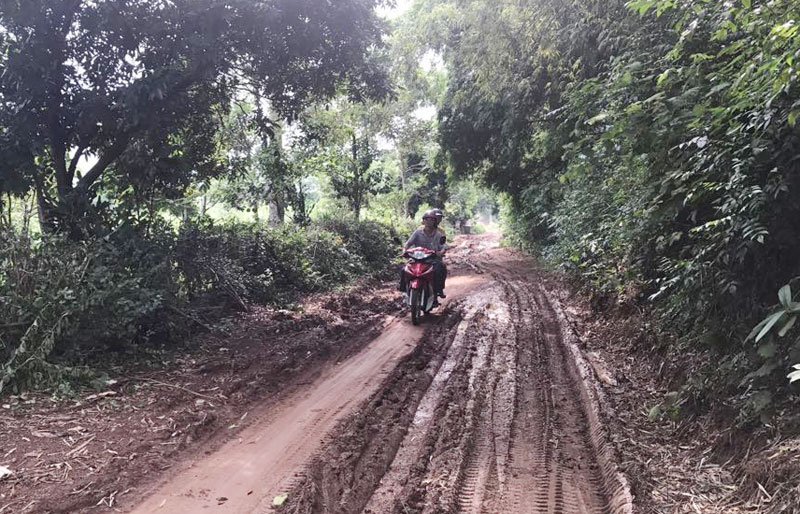
(HBO) – Van Son commune of Lac Son district of Hoa Binh has completed only 11 out of 19 criteria of the national target programme on new-style rural area building.

Roads in Loi village, Van Son commune of
Lac Son district are tough to travel.
Van Son commune has 12 communes and 1,027
households with 4,641 members. Over the past years, the local Party
organisation and government have paid great attention to mobilising resources
for infrastructure development, including rural transport system and irrigation
works to create optimal conditions for economic development, thus changing the
face of rural areas.
Being an agricultural locality, the income
of locals is at 19.5 million VND per person per year, while the rate of poor
households is 42 percent.
Bui Van Nen, Vice Chairman of the People’s
Committee of Van Son said that with low starting points, poor infrastructure
and canal system as well as tough roads, the progress of new-style rural
building in the commune has remained slow, affecting socio-economic development
of the locality.
Besides, locals’ awareness of the work is
still poor, while their production habit is backward, making it difficult to
apply science-technology to production, resulting in low productivity and outcomes
as well as poor living conditions, he said.
So far, Van Son district has finished
concretisation of roads linking it with other communes by 29.6 percent, while
100 percent of local roads are still pathways. Every day, locals have transport
their goods and agricultural products through muddy and rocky roads, including a
2.5km Van Son-Nhan Nghia road, and the road from Roc village in Van Son to Moi village in Thuong Coc, said
Nen.
In the rainy season, many roads connecting
communes and villages suffer from landslide, leading to serious traffic
congestion, including the commune-to-commune road of Van Son-Mien Doi, Van
Son-Thuong Coc and the local roads in Bung, Loi and Ray villages, he added.
Poor transport infrastructure has led to
difficulties in fulfilling the criteria in locals’ income. The economic
structure of Van Son is still 90 percent of agriculture as locals mostly live
on rice and maize cultivation.
Due to rough terrain, the farming area is
modest with backward cultivation techniques, the economic situation in the
locality has seen no breakthrough changes.
As part of efforts to improve incomes for locals,
the commune has coordinated with the Agriculture and Rural Development Office
of the district has opened training courses to give local cultivation, and
animal breeding techniques, while encouraging them to develop hill-based
economy as well as craft industries.
However, locals’ poor awareness has still
resulting in many difficulties in their access to science and technology, Nen
stated./.
The emulation movement "Hoa Binh joining hands to build new-style rural areas” has been widely spreading, becoming a driving force that motivates the localities to renew rural landscapes and improve the material and spiritual lives of the residents. In this movement, the people play a central role-both as the main implementers and direct beneficiaries of its outcomes.
In response to the global digital revolution, Hoa Binh Newspaper is transforming itself into a modern and multi-platform media hub, blending cutting-edge technology with a restructured newsroom and a new generation of tech-savvy journalists.
Hoa Binh province’s Association of the Elderly recently held a conference to review the project on expanding the inter-generation self-help club model until 2025.
In a move to implement Resolution No. 57-NQ/TW, issued on December 22, 2024 by the Politburo, which targets breakthroughs in science-technology development, innovation, and digital transformation, the Hoa Binh provincial Department of Health has issued a plan to roll out the "Digital Literacy for All” campaign within the local health sector.
An Nghia Commune (Lạc Sơn District) is one of the communes that achieved the tha standard of the national new rural area in 2018. Entering a new development phase, the commune is now trying to meet the criteria for the advanced new rural development. With the strong political will and the public consensus, the commune is gradually overcoming the challenges to reach this goal, aiming for the sustainable development.



